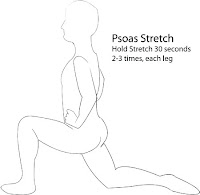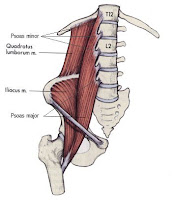I’ve been showing you stretches to open up your hip flexor complex, which includes the iliopsoas (iliacus and psoas major together) muscle. Another muscle, which is an integral part of this complex and also needs attention in many people, is the rectus femoris (part of the quadriceps muscle) on the front of the thigh.
The rectus femoris attaches from the front of the pelvis to the shin (tibia). It is involved in both knee extension (straightening the knee) and hip flexion. In some people, it may be the hip flexor muscle in need of the most lengthening. When this muscle is tight, it can lead to a number of problems, most notably low back pain and patellar tendonitis. In either of these cases, stretching will bring quick relief and also prevent the formation and continuation of a chronic problem.
In the video below, I demonstrate four stretches that are excellent openers for the rectus femoris or quadriceps, and thus the hip, low back and knees. The are actually four successive levels varying in difficulty and intensity. You should try each one from the beginning to determine your current level. When you find the one that challenges you the most, but which you can still do without causing too much pain or loss of balance, practice it for one to two weeks before trying the next level.
Within that time, you should be able to master the current level, if you do the stretch every day; and by moving on to the next level, that one will then become challenging but doable. A principle of all exercise, whether we are talking weight lifting, cardio or stretching, is that you will have to try the next highest level at a lower intensity (whether that means reps, duration, increased intensity of stretch, or whatever) before you will be able to do it regularly and with greater ease. For example, you won’t be able to master the third level stretch in the video until you can do the second level with some ease; then by taking it to the next level, and practicing, even if it’s uncomfortable, for a shorter period should in time allow you to do that next level comfortably (as comfortable as a stretch can be), and so on to the next level beyond that. In other words, you won’t be ready for the next level until you do it repeatedly, and ultimately, that will become your next level of mastery (also a metaphor for life!)
Try these stretches to add even greater opening of your hip flexor complex. I guarantee that once you master all four levels of this rectus femoris stretch, your low back, hips and knees will thank you. And you’ll also see some amazing improvements in your posture. Try them, you’ll see.













